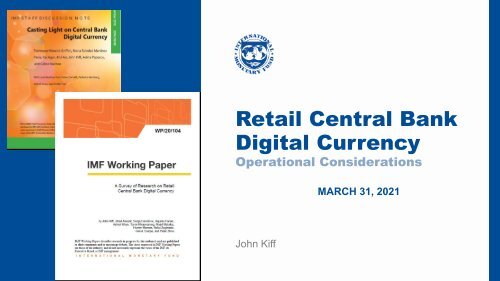Retail CBDC Operational Considerations
- No tags were found...
Create successful ePaper yourself
Turn your PDF publications into a flip-book with our unique Google optimized e-Paper software.
<strong>Retail</strong> Central Bank<br />
Digital Currency<br />
<strong>Operational</strong> <strong>Considerations</strong><br />
MARCH 31, 2021<br />
John Kiff<br />
INTERNATIONAL MONETARY FUND 1
A retail <strong>CBDC</strong> is a widely accessible digital<br />
representation of a sovereign currency that is<br />
issued by, and a liability of, a jurisdiction’s<br />
central bank or monetary authority.<br />
INTERNATIONAL MONETARY FUND 2
Where Do <strong>Retail</strong> <strong>CBDC</strong> Fit in the Money Matrix<br />
INTERNATIONAL MONETARY FUND 3
Jurisdictions Where <strong>Retail</strong> <strong>CBDC</strong> Is Being Explored (as of March 17, 2021)<br />
Where central banks have launched or piloted (or soon will)<br />
Bahamas (fully launched) Eastern Caribbean (03/31/21 pilot launch) Uruguay (pilot completed)<br />
China (pilot launched)<br />
Ecuador (pilot done & project discontinued)<br />
Where central banks have done proofs of concepts (or soon will)<br />
Jamaica (see also here and here)<br />
Sweden (proof of concept started)<br />
Korea (proof of concept started)<br />
Ukraine (proof of concept done)<br />
Where central banks are in advanced stages of research and development<br />
Canada Japan United States<br />
Euro Area<br />
United Kingdom<br />
Where central banks are still in the exploratory stages<br />
Australia India Norway<br />
Brazil Indonesia Philippines<br />
Chile Israel Russia<br />
Curaçao en Sint Maarten Kenya South Africa<br />
Denmark Kuwait Switzerland<br />
Eswatini Madagascar Thailand<br />
Finland Malaysia Trinidad and Tobago<br />
Ghana Mauritius Tunisia<br />
Hong Kong SAR Morocco Turkey (update)<br />
Iceland<br />
New Zealand<br />
Where central banks have explored or are exploring issuing retail <strong>CBDC</strong><br />
(according to reputable news sources)<br />
Bahrain Iran Pakistan<br />
Egypt Kazakhstan Palestine<br />
Haiti Lebanon Rwanda<br />
INTERNATIONAL MONETARY FUND 4
Central Bank Motivations for Issuing <strong>CBDC</strong><br />
Emerging Market & Developing<br />
Economies<br />
Financial digitalization and<br />
inclusion<br />
Reducing physical cash costs and<br />
risks<br />
Reducing dollarization<br />
Advanced Economies<br />
Enhancing payment system competition<br />
In face of declining cash usage<br />
Distributing stimulus payments<br />
Improving monetary policy effectiveness: targeted policy, accessing granular<br />
real-time payments data, breaking through lower zero bound on policy rates<br />
Attempting to derail global stablecoin adoption<br />
INTERNATIONAL MONETARY FUND 5
Risks of Issuing <strong>CBDC</strong><br />
• <strong>CBDC</strong> could affect financial stability and banking intermediation if it<br />
competes with bank deposits.<br />
• Banks could also increase their reliance on wholesale funding, with<br />
implications for funding cost and stability, and market discipline.<br />
• Several suggestions have been put forward to control potential banking<br />
sector disintermediation, including holding/transaction limits, variable<br />
interest rates/fees, and restricted conversion modalities.<br />
• <strong>CBDC</strong> may increase bank run risks by offering a readily available, safe,<br />
and liquid alternative to deposits, depending on the <strong>CBDC</strong>’s design.<br />
• <strong>CBDC</strong> could affect the transmission of monetary policy.<br />
• <strong>CBDC</strong> of reserve currency countries available across borders could<br />
increase currency substitution (“dollarization”).<br />
INTERNATIONAL MONETARY FUND 6
Analysis and identification of all<br />
risks (macroeconomic, monetary<br />
policy, financial stability, cyber).<br />
<strong>CBDC</strong> Decision-Making Process Flow<br />
Clarifying objectives provides a framework for balancing pros and cons of <strong>CBDC</strong><br />
issuance and guiding design options. The decision-making process starts with<br />
understanding thoroughly the problem to be solved and the full array of solutions.<br />
Foundational capacity assessment to determine if appropriate legal, regulatory/<br />
supervisory frameworks in place, CB’s governance, organization and risk management<br />
up to challenge of managing <strong>CBDC</strong>? If not, capacity building may be in order.<br />
Identification of user and payment ecosystem preferences/requirements including<br />
via surveys and focus groups will drive design choices, and feasibility of <strong>CBDC</strong>.<br />
Key design choices include operating model, degree of anonymity/privacy, availability/<br />
limitations, renumeration, and platform (centralized v decentralized database)<br />
Technology solution assessment vs<br />
design, risks and adoption criteria via PoCs.<br />
Public acceptance, impacts and use cases<br />
assessment with pilots.<br />
Issue <strong>CBDC</strong>?<br />
If PoC reveals gaps, further research<br />
on technology and design required.<br />
If pilots reveal gaps, further research on<br />
use cases, design and impact.<br />
Exit/postpone <strong>CBDC</strong> project at least temporarily.<br />
INTERNATIONAL MONETARY FUND 7
To <strong>CBDC</strong> or Not To <strong>CBDC</strong><br />
Objective: Support financial<br />
digitization & inclusion and/or<br />
reduce cash usage<br />
Is digital infrastructure robust<br />
& widely available? If not<br />
upgrade and/or expand.<br />
Regulatory and policy levers<br />
are unable to incentivize<br />
private PSPs to step up?<br />
Objective: Enhance payment<br />
system competition / reduce<br />
monopoly distortions<br />
Are platforms contestable &<br />
interoperable? If not, develop<br />
and encourage contestability<br />
& interoperability<br />
Regulatory and policy levers<br />
are unable to increase<br />
competition/ reduce monopoly<br />
distortions?<br />
Consider issuing <strong>CBDC</strong><br />
Objective: Offset declining<br />
usage of cash, loss of<br />
monetary sovereignty.<br />
Policy levers cannot offset<br />
declining use of cash or<br />
central bank money? If yes,<br />
put them in place.<br />
Objective: Enhance monetary policy effectiveness? If yes, consider interest-bearing <strong>CBDC</strong> and making<br />
cash more costly to hold.<br />
INTERNATIONAL MONETARY FUND 8
<strong>CBDC</strong> Business Model <strong>Considerations</strong><br />
Are there enough willing PSPs to run a<br />
whole <strong>CBDC</strong> ecosystem?<br />
Yes<br />
Consider two-tier or synthetic <strong>CBDC</strong><br />
No<br />
Does CB have capacity to (or want to) run a<br />
<strong>CBDC</strong> ecosystem by itself?<br />
Yes<br />
Consider a single-tier <strong>CBDC</strong>?<br />
Incentives<br />
A <strong>CBDC</strong> ecosystem should create economic incentives for all participants to participate in ways that<br />
serve central bank interests. In the case of a two-tier <strong>CBDC</strong> or s<strong>CBDC</strong> ecosystem, there should be a<br />
cost-effective business model for such PSPs with enough revenues from interest spreads, fees, and<br />
cross-subsidization, as well as controllable fixed and variable costs. Also, economic incentives for<br />
users and merchants should leave room for enough users to reach critical mass and incentivize<br />
network buildup while promoting PSP market competition. For example, regulations that encourage<br />
interoperability of competing payment systems to encourage new entrants and reduce concentration<br />
risk should take care not to adversely impact network build-up.<br />
INTERNATIONAL MONETARY FUND 9
Design <strong>Considerations</strong><br />
• Availability and limitations: Decisions have to be made about who can<br />
hold <strong>CBDC</strong>, limits on holding/transaction size, offline availability and<br />
convertibility limits.<br />
• Privacy and transparency: Financial integrity, privacy and transparency<br />
requirements need to be balanced.<br />
• Interest-bearing: <strong>CBDC</strong> could be remunerated to modulate demand or<br />
enhance monetary policy transmission. Even if not interest bearing at first,<br />
capacity should be incorporated into design.<br />
• Programmability: Point-of-sale tax payments, integration with physical<br />
devices or IoT applications, or automate distribution of economic relief<br />
based on specific demographic or other characteristics.<br />
• Ledger (de)centralization: If a decentralized platform is chosen, decisions<br />
have to made as to whether ledger maintenance is permissioned or public.<br />
• Cross border functionality and inter-operability?<br />
INTERNATIONAL MONETARY FUND 10
Cyber Risk Management Workflow<br />
INTERNATIONAL MONETARY FUND 11
INTERNATIONAL MONETARY FUND 12
Discussion and Questions?<br />
INTERNATIONAL MONETARY FUND 13
References<br />
Adrian, T., and T. Mancini-Griffoli. 2019a. “The Rise of Digital Money,” IMF Fintech Note 19/01.<br />
----. 2019b. “Central Bank Digital Currencies: 4 Questions and Answers,” International Monetary Fund Blog,<br />
December 12.<br />
Auer, R. and R. Boehme. 2020. “The Technology of <strong>Retail</strong> Central Bank Digital Currency,” Bank for International<br />
Settlements Quarterly Review, March.<br />
Bank of England. 2020. “Central Bank Digital Currency: Opportunities, Challenges and Design,” Discussion Paper,<br />
March.<br />
Bindseil, U. 2020. “Tiered <strong>CBDC</strong> and the Financial System,” European Central Bank Working Paper No. 2351,<br />
January.<br />
Bossu, W., M. Itatani, C. Margulis, A. Rossi, H. Weenink and A. Yoshinaga. 2020. “Legal Aspects of Central Bank<br />
Digital Currency: Central Bank and Monetary Law <strong>Considerations</strong>,” IMF Working Paper No. 20/254.<br />
European Central Bank. 2019. “Exploring Anonymity in Central Bank Digital Currencies,” ECB In Focus, December.<br />
Kiff, J., J. Alwazir, S. Davidovic, A. Farias, A. Khan, T. Khiaonarong, M. Malaika, H.K. Monroe, N. Sugimoto, H.<br />
Tourpe, and P. Zhou. 2020. “A Survey of Research on <strong>Retail</strong> Central Bank Digital Currency,” IMF Working Paper No.<br />
20/104.<br />
Mancini-Griffoli, T., M.S. Martinez Peria, I. Agur, A. Ari, J. Kiff, A. Popescu, and C. Rochon. 2018. “Casting Light on<br />
Central Bank Digital Currency,” IMF Staff Discussion Note SDN/18/08.<br />
Shah, D., R. Arora, H. Du, S. Darbha, J. Miedema, and C. Minwalla. 2020. “Technology Approach for a <strong>CBDC</strong>,” Bank<br />
of Canada Staff Analytical Note 2020-6.<br />
Sveriges Riksbank. 2020. Economic Review: Second Special Issue on the E-Krona.<br />
INTERNATIONAL MONETARY FUND 14

















